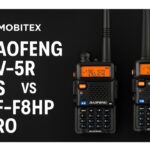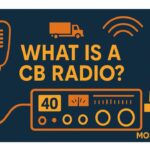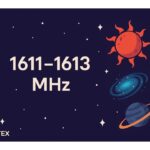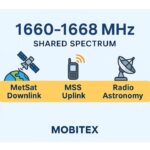Frequency
1524 MHz
Range
1525–1559 MHz
Band Group
L‑Band (1–2 GHz)
🌐 Summary
The 1524 MHz allocation is part of the L‑Band (1–2 GHz) spectrum. This range is used worldwide for critical applications that keep our communications and infrastructure running smoothly. On this page we highlight how each band is applied in real systems, from regulatory assignments to everyday devices. Our goal is to make spectrum data clear and practical for engineers, regulators, and enthusiasts alike.
Key uses of this band include: 1524 MHz lies within the L‑band MSS downlink block (1525–1559 MHz). It supports satellite services to user terminals and must strictly protect RNSS above 1559 MHz..

🔍 Explore the full RF Spectrum database
📡 Band & Geometry key
| Field | Value |
|---|---|
| Wavelength (m) | 0.19685 |
| Waveforms | |
| Antenna Form Factor (Typical) | |
| Band Family | Low to moderate interference; RNSS protection required >1559 MHz |
| Band | L-Band |
| Primary Common Name | Mobile‑Satellite Downlink (MSS DL) |
| FSPL @ 1 km [dB] | 96.1 |
| FSPL @ 10 km [dB] | 116.1 |
| Fresnel Radius @ 1 km (m) | 7.02 |
| Band Group | L‑Band (1–2 GHz) |
| Tax Band Family | L‑Band |
| Tax Band Class | 1518 MHz – 1559 MHz Mobile‑Satellite Downlink |
🧩 Applications & Usage
| Field | Value |
|---|---|
| Primary Application | Mobile‑Satellite Service (MSS) downlink reception |
| Lower Neighbor Use | LTE/NR SDL; coordination at 1518–1525 edge |
| Upper Neighbor Use | GNSS — strict protection |
| Typical Services Devices | |
| Market Common Devices | Satellite phones, IoT terminals, aircraft and shipborne antennas |
| Refarming Use | Not typical (dedicated satellite band) |
| Device Ecosystem Size | Global (satphones, IoT, maritime/aviation terminals) |
| Device Hotspots (MHz) | 1525–1555 MHz |
| Device Category | |
| Typical Use Cases | |
| Modulation (Device) | |
| Channel Width (Device) [kHz] | |
| Device Region Profiles | Global MSS coverage; uniform device ecosystem across regions |
| Per-Region EIRP Or Duty (Device) | |
| Allocation Relevance (Device) | |
| Adjacent-Band Collision Risks (Device) | |
| Example Devices Or Skus | Inmarsat IsatPhone; Iridium GO!; Thuraya XT‑PRO |
| Common Protocols | ETSI EN 301 681; ITU‑R M.1183 (MSS systems) |
🗒️ Notes
| Field | Value |
|---|---|
| Receiver Selectivity Notes | ≥60–80 dB rejection into 1559–1610 RNSS band |
| Interference Notes | |
| Compatibility Risk Notes | |
| Notes | |
| Propagation Notes |
⚙️ Technical Rules
| Field | Value |
|---|---|
| Lower Band Frequency Limit | 1525 |
| Upper Band Frequency Limit | 1559 |
| EIRP Indoor Limits | |
| EIRP Outdoor Limits | |
| PSD Limit | |
| Emission Mask Class | Satellite DL OOBE per operator/ETSI |
| Guardband Minimum [kHz] | 2000 |
| Typical Bandwidths | 12.5 kHz–5 MHz (system‑dependent) |
| Autocalculated Bandlimits | |
| Typical Bandwidths (Estimated) | 12.5 kHz–5 MHz (system‑dependent) |
| Max EIRP [dBm] | |
| Power Source Or Duty Profile (Typical) | |
| Channelization Plan | |
| Channelization | Operator‑specific satellite carriers |
| Guard Band Requirement | |
| OOB Emission Limit [dBm/MHz] | |
| Spurious Emission Limit (dBm) | ≤ −36 dBm/100 kHz near 1559 MHz (RNSS) |
| RX Blocking Min [dBm] | Device ≥ −20 dBm (satellite receiver ref.) |
| Duplexing | |
| Duplexing Information | Downlink (space‑to‑Earth) |
| Uplink Pairing | Mobile‑Satellite Downlink (MSS DL); space‑to‑Earth transmissions |
| Downlink Pairing | Downlink from satellite; uplink in separate MSS band |
| Paired Band Info | Earth‑to‑space uplink in separate MSS bands |
| Max EIRP [dBm] | |
| Channelization Block Size | Operator carriers (kHz–MHz) |
| 3GPP Band Number | |
| Example 3GPP Bands | |
| LTE Uplink Bands | |
| LTE Downlink Bands | |
| NR Uplink Bands | |
| NR Downlink Bands | |
| Guard Bands | ≥2–4 MHz below 1559 MHz to protect RNSS |
| Protocol Or Standard |
🌎 Country Overrides
| Field | Value |
|---|---|
| Tax Service Category | Satellite Mobile |
| Tax License Type | Licensed satellite service |
| Tax Regions | Global (per operator & admin) |
| ITU Region 1 (Europe, Africa, Middle East (west of Persian Gulf), Western Russia & Mongolia) | Region 1: MSS DL (1525–1559); protect RNSS ≥1559. |
| ITU Region 2 (North America, South America, Central America, Caribbean, Greenland, Eastern Pacific Islands (Americas region)) | Region 2: MSS DL (operator/licensed); national coordination. |
| ITU Region 3 (Asia, Australia, Pacific Islands, Oceania, Indian Subcontinent, East Asia & Southeast Asia) | Region 3: MSS DL in use; RNSS protection above 1559. |
| License Type | |
| Primary Application | Mobile‑Satellite Service (MSS) downlink reception |
| Primary Services | Satellite downlink to user terminals (space‑to‑Earth) |
| Spurious Emission [dBm] | ≤ −36 dBm/100 kHz near 1559 MHz (RNSS) |
| Lower Neighbor Use | LTE/NR SDL; coordination at 1518–1525 edge |
| Upper Neighbor Use | GNSS — strict protection |
| Licensing Model | |
| Typical Services Devices | |
| US FCC Alloc | Part 25 Mobile‑Satellite downlink (space‑to‑Earth)– |
| CA IC Alloc | – |
| UK Ofcom Alloc | 1525–1559 MHz: MSS downlink (Ofcom UKFAT)– |
| US Ref | |
| Typical Bandwidths | 12.5 kHz–5 MHz (system‑dependent) |
| Market Licensing Model | Licensed spectrum – coordinated via ITU / satellite operator agreements |
| Market Common Devices | Satellite phones, IoT terminals, aircraft and shipborne antennas |
| Fresnel Radius (1st, 1 km) [m] | 7.02 |
| Typical Bandwidths (Estimated) | 12.5 kHz–5 MHz (system‑dependent) |
| Auction Status | Not auctioned to MNOs; licensed to satellite operators |
| Refarming Use | Not typical (dedicated satellite band) |
| Typical Site Spacing km | / |
| Device Ecosystem Size | Global (satphones, IoT, maritime/aviation terminals) |
| Traffic Load Share | |
| Device Hotspots (MHz) | 1525–1555 MHz |
| Device Category | |
| Typical Use Cases | |
| Typical Center Frequencies [MHz] | 1530, 1545, 1555 |
| Rule Part (Fcc Or Region) | |
| Modulation (Device) | |
| Channel Width (Device) [kHz] | |
| Device Region Profiles | Global MSS coverage; uniform device ecosystem across regions |
| Per-Region EIRP Or Duty (Device) | |
| Allocation Relevance (Device) | |
| Adjacent-Band Collision Risks (Device) | |
| Example Devices Or Skus | Inmarsat IsatPhone; Iridium GO!; Thuraya XT‑PRO |
| Antenna Form Factor (Typical) | |
| Power Source Or Duty Profile (Typical) |
🛡️ Regulatory & Neighbors
| Field | Value |
|---|---|
| Lower Band Frequency Limit | 1525 |
| Upper Band Frequency Limit | 1559 |
| Rx Blocking Min dBm | Device ≥ −20 dBm (satellite receiver ref.) |
| Lower Neighbor Use | LTE/NR SDL; coordination at 1518–1525 edge |
| Upper Neighbor Use | GNSS — strict protection |
| Lower Neighbor Band | |
| Lower Neighbor Range | 1492–1518 MHz (SDL) & 1518–1525 MHz (guard) |
| Upper Neighbor Label | |
| Upper Neighbor Range | 1559–1610 MHz (RNSS/GNSS) |
| Adjacent-Band Collision Risks (Device) | |
| Real-World Range (Indoor/Outdoor) | |
| US FCC Alloc | Part 25 Mobile‑Satellite downlink (space‑to‑Earth)Part 25 Mobile‑Satellite downlink (space‑to‑Earth) |
| CA IC Alloc | |
| UK Ofcom Alloc | 1525–1559 MHz: MSS downlink (Ofcom UKFAT)1525–1559 MHz: MSS downlink (Ofcom UKFAT) |
| Regulatory References | US: ; CA: ; UK: |
| Global Harmonization | High (MSS allocations globally) |
| Crossborder Coordination | International satellite coordination; RNSS protection obligations |
| Sharing Mechanism | |
| Auction Status | Not auctioned to MNOs; licensed to satellite operators |
| Guard Or Pair | ETSI EN 301 681; ITU-R M.1183; MSS system-specific specs |
📈 Market & Measurements
| Field | Value |
|---|---|
| Noise Floor | Satellite downlink (space-to-Earth); GEO/MEO/LEO systems |
| Interference Cases | Protect RNSS >1559 MHz; emission mask per ITU/ETSI limits |
| Lower Neighbor Range | 1492–1518 MHz (SDL) & 1518–1525 MHz (guard) |
| Upper Neighbor Range | 1559–1610 MHz (RNSS/GNSS) |
| Interference Notes | |
| Market Licensing Model | Licensed spectrum – coordinated via ITU / satellite operator agreements |
| Market Commercial Value | High – global MSS applications (maritime, aviation, IoT, emergency comms) |
| Market Common Devices | Satellite phones, IoT terminals, aircraft and shipborne antennas |
| Market Deployment Density | High (satphones, IoT, maritime/aviation terminals) |
| Noise Floor (Estimated) | Satellite downlink (space-to-Earth); GEO/MEO/LEO systems |
| Market Commercial Value (Estimated) | High – global MSS applications (maritime, aviation, IoT, emergency comms) |
| Ecosystem Maturity | High (maritime, aviation, IoT tracking) |
| Indoor Penetration | Moderate (L‑band); sky view improves performance |
| Known Interference | |
| Device Ecosystem Size | Global (satphones, IoT, maritime/aviation terminals) |
| Real-World Range (Indoor/Outdoor) | |
| Antenna Form Factor (Typical) | |
| Ecosystem Maturity | High (maritime, aviation, IoT tracking) |
| Device Ecosystem Size | Global (satphones, IoT, maritime/aviation terminals) |
| Chipset Availability | |
| Operator Deployments | |
| Technology Generations Deployed | |
| Roaming Support | Global via satellite footprint |
| Traffic Load Share | |
| Indoor Penetration | Moderate (L‑band); sky view improves performance |
| Known Interference | |
| Occupancy | Mobile-Satellite downlink to terminals (voice/data/IoT) |
| Occupancy Bucket Pct | >90% global utilization (MSS downlink in constant use) |
| Latency Profile | |
| Common Channels Or Profiles | |
| Security Features | |
| Lbt Or Fhss Requirement | No (channelized satellite downlink) |
| Popularity (Installed Base) | |
| Coexistence Tips | |
| Latency Class | |
| Device Hotspots (Scoped && Tagged) |



